1/48 Seversky P-35A.
This is the recent Wolfpack re-issue of the Hobbycraft kit. While it is old, the basic plastic is pretty nice with a few accuracy issues. I remember building the HC P-35 around 1995 and enjoying it, so I thought I'd give this one a go. Wolfpack upgraded the kit by adding some very nice photo etch parts. Color for the cockpit, brass for the engine and exterior. The package also includes excellent Cartograf decals, masks, and a resin boss for the prop. I used about 90% of the photo etch and it really makes the cockpit and engine pop out at you. The resin prop boss is a big improvement over the kit part too.
The basic kit's main accuracy issues involve the wing. It lacks the cutout for the P-35A landing light on the left wing. It also lacks the small fairings from the exhaust to the wing root. Hobbycraft used the same P-35 wing for the P-35, P-35A, and Seversky racer kits. I split the difference. I cut out the landing light, made a bulb from clear sprue, and added a scotch tape cover. I ignored the missing small wing root fairings. It's not that noticeable and I'll probably never turn the model upside down again. I also decided to use a spare Airfix US P-40 seat for the pilot. The PE seat just didn't cut it and I used the kit supplied plastic seat to replicate the passenger seat these planes had in the lower fuselage, visible through the clear panel on the right side. I also added a false floor and a bit of structure in this area using sheet styrene.
P-35As were built for Sweden and seized by the US government before delivery. They were sent to the Philippines in Swedish insignia, remarked and assigned to the 17th and 34th Pursuit squadrons. Eventually they were camouflaged in olive drab over neutral gray. The camo was applied directly over polished aluminum without primer and degraded quickly. I painted this kit with Xtracolor enamel faded Olive Drab over Neutral Gray. Everything else is painted with Humbrol enamels. I replicated the chipped paint by stippling the airframe with small pieces of sponge dipped in Humbrol #11. I drilled a hole in the vertical fin to install a brass antenna post with CA. The antennas themselves are EZ line. A blast of Testors dull cote sealed it all up. Now, on to the Dora Wings P-43!
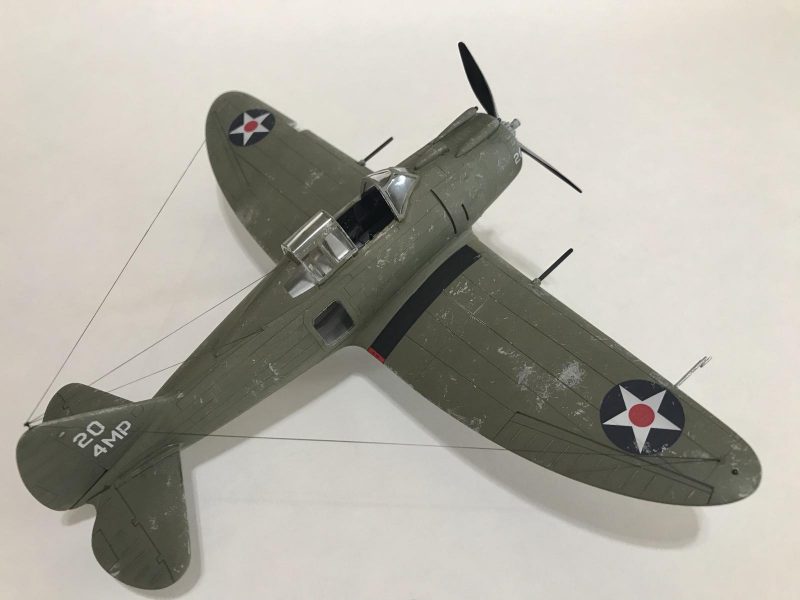

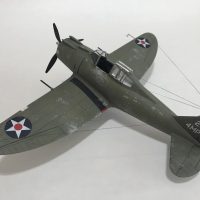


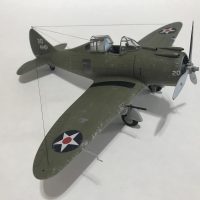

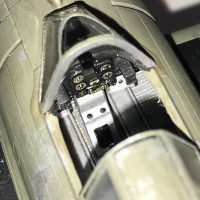
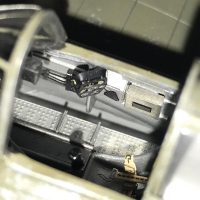

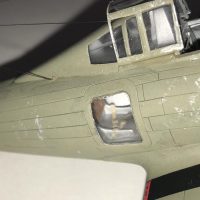
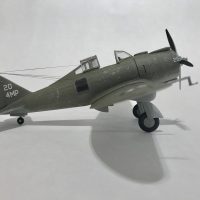
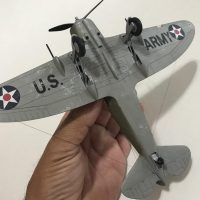
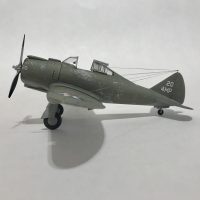

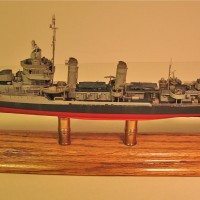
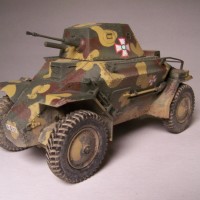

Hi John!
This is a magnificent P-35! Your excellent work, your modifications and the extra stuff provided by Wolfpack resulted in this beauty!
I have the Academy kit, which is the actually the Hobbycraft kit, so I will keep in mind your mods upon building it.
Thanks, Spiros!
Great build! Love the paint and weathering work on it.
Thanks, Greg!
Great P-35 John! I've got the HC kit in paint at the moment. I like the Wolfpack upgrades, and you highlight them nicely in your pictures, so thanks. It looks like either they, or Academy, must have fixed the front canopy framing, which HC grossly mis represented. Thanks for sharing! I'll also be building the P-43, to complement the 35. 🙂
Hi Andrew @pb_legend!
Just checked the kits at scalemates.com, and it quotes tht the Academy "rebox"has "new parts" (couldn't find specifics by glancing at the instruction sheets...). So, chances are that Academy might have improved some plastic kit parts, too (I will find out upon building/researching mine!).
Thanks for constructive commenting!
Thanks, Andrew! Unless the clear sprues were different for the P-35 and P-35A kits, yes they must’ve fixed it. Attached is a pic of my HC P-35 from 1995.
1 attached image. Click to enlarge.
That's the offender John, the same canopy is standard in my P-35A boxing. It doesn't even match the artwork on the lid, so who knows how it ended up in plastic form. Your old build looks nice too!
The P-35 n P-35A were the same, the latter was intended for the Swedish air force but got embargoed and ended up in USAAF service...at least as far as I understand things.
Fantastic looking P-35A. Great paintwork! Really like the cockpit & compartment area.
Thanks, Doug!
Great job on the paint, build and photos! Looking forward to the DW P-43 getting the @j-healy treatment!
Thanks, Eric!
John:
Nice model and a good result.
However, there are a couple points on the camouflage. This is admittedly an area where there is very little information. I think my interview with 17th PS pilot Lamar Gillet, the P-35A pilot who shot down a Zero in the Philippines (it popped out of the clouds in front of him accidentally and "I used up all my ammo shooting it down, I was so inexperienced"), probably provides 98% of the accurate information on the topic.
Anyway, in mid-October 1941, knowing war was coming, the P-35As were painted in camouflage over their aluminum finish. This was done without primer, and was only the OD over the upper surfaces (try painting, or doing anything, to the lower surfaces of an airplane sitting on its gear, I speak from a month's experience stripping paint off a Corsair 45 years ago). The paint, lacking primer to stick to, mostly washed off when the airplanes were flown through the frequent rain storms of the Philippines monsoon season and by the time of the Japanese attack "they looked like they had already been through a war."
None of the above is a complaint, since your model gets the closest to this reality of any Philippines P-35A I have yet seen done, and I am certain I am the only person left alive with that first-hand knowledge. I want to pass on the best information for anyone who's going to get this kit (thanks for the info it exists).
Those who may be interested in full and complete information on the fighters in the Philippines and the amazing adventure of Lamar Gillet, who shot down a Zero, had his P-35A stolen and ended up an infantryman on Bataan, survived the Death March and three years as a POW in Japan, as well as much else, can now pick up my new book "I Will Run Wild: The Pacific War From Pearl Harbor To Midway", which was released yesterday.
Thanks so much! I just ordered the kit from Sprue Brothers. Gonna make Lamar's raggedy-andy airplane.
Thanks, Tom. There are some color pics and even films of these planes that I’ve seen. The undersides are impossible to see. I never would’ve guessed they were unpainted but it makes perfect sense. To stray a bit, what is your knowledge of 56FG P-47 undersides? Lots of decal sheets recommend medium sea grey, but my eyes see natural metal on most of these.
Good to know. I just began to do chipping on my Neutral Grey. Looks like I will be doing more excessive chipping than originally planned... 😉
John, @j-healy
Camouflage, unit markings, and radio call signs of the 56th, according to Wiki...
I too have a few P-47's on the bench. One of them is going to be the highly debatable plane that Gabreski was shot down in. This is what wiki has to say about the colors and it even goes into other details.
"The three component squadrons, the 61st, 62d, and 63d Fighter Squadrons, flew P-47C (blocks 2 and 5) from February 1943 to April 1943, P-47D (blocks 1 through 30) from June 1943 to March 1945, and P-47Ms from January 1945 to 10 October 1945. All 130 P-47M models served with the 56th FG before it redeployed from UK.
The P-47C and P-47D aircraft received by the 56th FG were finished in factory-applied olive drab (OD) with gray lower surfaces. Because the P-47 was the only radial engined allied fighter, the danger of other allied fighters mistaking it for the Fw 190 caused VIII Fighter Command to have 24-inch (610 mm) white cowl bands painted on the noses of P-47s after March 1943. Other rapid identification measures used were white banding on both the tail fin and horizontal stabilizers, and the use of oversized USAAF roundels on the undersides of both wings.
The USAAF ended the factory-applied camouflage on all aircraft produced after 13 February 1944, and the first unpainted block 21 "razorback" canopy and block 25 "bubble-top" canopy models arrived in May. The first "silver" aircraft, 42-26044, was left uncamouflaged, given the name Silver Lady, and flown in combat by Capt. James Carter and Major Les Smith of the 61st FS. The first bubbletops, dubbed "Superbolts", were assigned to the group and squadron commanders until more became available.
The 56th applied field camouflage to most but not all of these replacement fighters. Most bubbletops were given an RAF-style "shadow-shading" (disruptive) pattern of "RAF green" (a shade similar to olive drab) overlaid on light sea gray (another RAF shade) on upper surfaces, while most razorbacks were field-painted in overall dark OD on upper and light gray on lower surfaces. Shadow shading, however, appeared in a variety of schemes and colors, adding to the distinction of the group's aircraft.
When P-47M's appeared in January 1945, each squadron adopted an individual camouflage scheme on upper surfaces while lower surfaces of the fighters were left unpainted. The 61st used a matte black color that faded to a dark purple. The 62d continued the green-and-gray shadow-shading pattern, while the 63d went to a shadow-shading pattern of "deep Mediterranean blue" (indigo) applied over sky blue.
VIII Fighter Command assigned the 56th Fighter Group two-letter squadron identification codes to be painted on the fuselages of its fighters, and each squadron assigned its aircraft individual letter identifiers. (The letters chosen for the 56th had previously been assigned to the 1st Fighter Group before it went to the Twelfth Air Force.) In early February 1944 the 56th replaced its white cowl bands with a different color for each squadron. This innovation lasted until mid-March, when VIII Fighter Command adopted a color system for all Eighth Air Force fighter groups. The 56th painted its noses red and later applied the squadron colors to the tail rudders of its Thunderbolts, an innovation that VIII Fighter Command also borrowed. The 56th discontinued use of squadron colors when it changed to P-47M's.
On 23 April 1944, VIII Fighter Command changed its system of radio call signs to reduce confusion when the fighter groups, now numbering a hundred or more fighters in their inventories, deployed two groups on escort missions ("A group" and "B Group"). Station call signs (RAF Halesworth's was STURDY, and RAF Boxted's DOGDAY) were unchanged, but all previous call signs were discontinued. In 1945 provision was also made for a C Group on missions (usually only 8 to 12 fighters) and all fighters assigned to a C Group mission used the common call sign.
Here's also a decent color chip showing the various RAF colors. The small numbers located in the corner of each color chip is the "closest" Federal Standards approximation color.
Here's also an original film clip that shows Gabby's P-47 as it taxies up to the camera. You can pause it and gather a ton of information about his plane. You really start to see his T-Bolt at the .20 second mark.
Hope this helps to answer some of your color questions.
Looks really nice John. I picked this kit up on ebay about a month ago and will do a Swedish version.
Thanks, Dale! I look forward to seeing yours.
You could do it really interesting if you want: Swefish crown markings on fuselage n wings and US red n white stripes on rudder. All aircraft polished aluminium.
I have the Academy kit in my stash. Is it also from the Hobbycraft molds?
Yes.
A great build! It must be Seversky/Republic month.
Thanks, Robert! Yes indeed, Seversky/Republic month it is!
All of the above comments and I can absolutely agree with Toms experience stripping underwing paint. It is the pits!
Thanks, Haslam!
John @j-healy
This is a great looking little fighter. You did a mighty fine job with her !
You can see where the P-47 ancestry lies with this one... I have two of these in the stash. One is the original Hobbycraft version, while the second one is a re-box by Academy. One of these days I hope to get to them. When I do, I hope that mine looks half as good as yours does. I also posted some information here in the reply section, about the questions you asked earlier. Hope this info helps...
I pressed the "liked" button too.
Stay safe my friend.
Thanks, Louis! It’s a fun older kit. Enjoy yours! The info you shared is most helpful.
Fantastic build, John.
Paint job and cockpit details are superb.
Thanks, John!
Looks terrific in that olive drab! Well done!
I won the Academy re-pop at a model show raffle and painted it in bare metal. That ill fitting canopy drove me crazy, but overall, I was satisfied with the kit and enjoyed building it.
I can’t imagine riding in that claustrophobic looking rear compartment. No thank you.
Looks like Dora Wings forthcoming P-35 will change up the game again.
Thanks, Eric! I plan on getting the Dora wings P-35 too.
Your P-35 looks GREAT. A real silk purse. A new tool is badly needed though. C'mon Dora...
Lookie what I got...found this video . At one time the P-35's had all their O.D. paint Or maybe twice. Also had a shot of Japanese troops climbing on a P-35, OD paint fully intact. Can't seem to find that, will keep searching.
BTW in my humble the B-17 C/D was the best looking large airplane ever built.
https://www.criticalpast.com/video/65675060831_Seversky-P-35-fighter_B-17-Flying-Fortress-bomber_Army-Far-East-Air-Force-personnel_B-17-lands
Thanks, Bill!
Great build of a plane that you don't see very often. I still have the original Hobbycraft kit that will eventually get built. I just watched an old detective movie from before the war and the Germans were trying to steal the plans to a new "wonder" plane, and it was the P-35. Cockpit is very nice!
Thanks, George. I think I remember seeing that movie years ago!